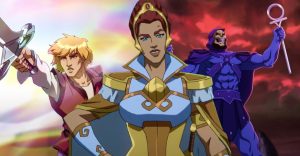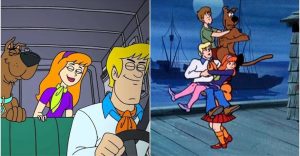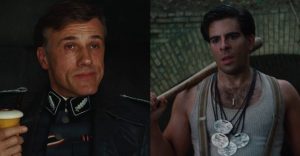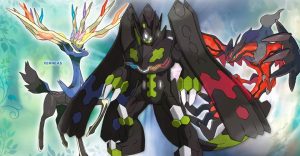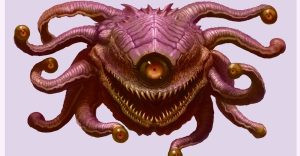His Dark Materials: Every Major Change To The Books In Season 1

His Dark Materials season 1 successfully kicked off Lyra’s story, but while the TV show is based on a series of novels, there were plenty of differences to the books. The majority of this first season adapted the events of the first book in Phillip Pullman’s incredible His Dark Materials series, The Golden Compass. However, it actually included a few nods to other books and stories within this universe, as well as a chunk of the second book The Subtle Knife.
It’s not surprising that the series would make some changes to the original story – that’s par for the course for an adaptation. And, thankfully, the changes that were made in this case all seem to not only make sense, but to actually make His Dark Materials a little bit better. Some changes make more practical sense (like changes to daemons), while others are there to make the world more accessible, and to set up future seasons of the show.
From the Magisterium to the Armored Bears, these are some of the biggest changes that His Dark Materials made – and what fans should expect to see change in season 2.
The Power Of The Magisterium Is Different In His Dark Materials

In the original His Dark Materials books, the Magisterium doesn’t have a huge amount of presence until the third (and final) book. They exist, of course, and are mentioned from the start, but they start off largely in the background, and the focus is kept on the Gobblers and Mrs. Coulter as the villains. The Magisterium does start to gain traction as one of the big bads as the series continues, but for the most part, The Golden Compass doesn’t spend much time on them at all.
In the His Dark Materials TV show, however, the Magisterium is a looming and powerful threat right from the start. The sheer size and power of the organization is shown in scenes of their mega-churches and intimidating headquarters, and many characters get increased screentime. Mrs. Coulter’s connections to the Magisterium are also increased, and she spends time visiting and talking to the Magisterium (and getting into power struggles with them) in a way that isn’t seen in the books (at least not at first).
Additionally, the power of the Magisterium over government, rather than just faith, is also increased. The concept of “scholastic sanctuary” is extremely prominent in the show, and scenes from Lord Asriel’s initial proposal and the fear of the scholars to the Magisterium (under Mrs. Coulter) searching Jordan college and accusing them of heresy hammer home the point that this is not just a powerful church, but the real power in this world.
His Dark Materials Changes Details Of Daemons & The Alethiometer

Two of the most important elements in His Dark Materials (both the TV series and the books) are the Alethiometer and the presence of daemons (part of the human soul, living outside the body in animal form). However, both of these got a few changes from the book to the series.
The Alethiometer receives a few cosmetic changes, from a round compass shape to a square, and with the addition of the engraved name of the man who invented them. However, that’s not particularly important, even if it was a bit jarring to devoted book fans at first. The more important changes are in the way that Lyra first learns to read the Alethiometer, and the legal status of it. In the books, Lyra’s first instinct is to start playing with the dials that move the needles, while in the series, she attempts to speak directly to it – it was a hilarious change, and one that is sure to appeal to viewers who have grown up in an age of smartphones and voice control. It’s also mentioned in the series that the Alethiometer is illegal (outlawed by the Magisterium), while in the books they are simply rare and valuable.
The daemons also have some minor changes – primarily that they can be significantly further from their humans than in the books, where it would be rare to see a daemon more than a couple of feet away. In the show, however, daemons are often shown far their humans – presumably for the simple reason that the cost of creating CGI daemons for every character in every scene would be prohibitive. However, this does create some confusion, especially when it comes to Mrs. Coulter. It seems at times that she and her Golden Monkey are severed, as the monkey goes so far from her (which even Lyra comments on), and they don’t seem to maintain the same pain/physical connection as other daemons and humans. However, this isn’t 100% confirmed, and it may be that this is just part of the new distance allowable in this version. There appears to be less prohibition on touching other daemons, too, which is a strange addition, but an understandable one, as it’s not vital to the story. It does mean that an important scene from the final book will have to be altered, though, as the importance of someone touching a daemon isn’t there.
Will Parry, Lord Boreal, & Major Spoilers

Possibly the biggest change between the books and the series has to be the early introduction of Will Parry and the “real” world. Originally, the entire first book in the series takes place in Lyra’s world, until the final moment that she steps through the rip that Lord Asriel created. Will and his world then appear at the start of the second book. However, the series made the decision to include Will’s story right from the start, culminating in his discovery of a “window” of his own.
The series also revealed Lord Boreal’s involvement and the true identity of Will’s father, which was a big surprise to many. However, this makes a lot of sense. Rather than going into a second season and having to tell Will’s entire story for the first episode (or more), this change allows for season 2 to jump right in with Lyra and Will’s first meeting. It also creates some more intrigue and ties the worlds together more effectively.
His Dark Materials’ Gyptians, Their Big Plan, & Billy Costa

The Gyptians are a big part of the His Dark Materials world, and for the most part, they stay the same. However, there were a few changes made throughout the series. The first big change was the introduction of a ceremony when a daemon settles (takes its adult form). This was an incredibly smart move on the part of the show, even if it doesn’t appear in the books (and isn’t mentioned as being a part of Gyptian culture), as it cements the fact that daemons settle, as well as creating a better idea of the cohesive society of the Gyptians and their place in this world as relative outcasts.
Another major change to the story of the Gyptians comes with third episode decision to have two of the Gyptians (including Tony Costa) break into Mrs. Coulter’s house to try and find details of Bolvanger and where the captured children are being kept. While this doesn’t happen in the books, it’s a useful inclusion in the series. For one thing, it shows what happens to a daemon when someone dies, and strengthens the lore around their connection. For another (potentially more important), it also keeps the plans of the Gobblers front and center, and provides some useful information for the Ggyptians to use. In the His Dark Materials books, they head out in a general ‘North’ direction, getting some aid from the witches to find Bolvanger – which is possible, but it’s definitely helpful to see them gain some more concrete information to help them in their rescue attempt.
The final, and most heartbreaking, change is in the combination of Billy Costa with another book character, Tony Makarios. In the His Dark Materials books, Tony is a street kid who gets captured by the Gobblers, and is the character who is severed and found by Lyra in the Northern village. In the series, though, this happens to Billy Costa instead. It’s an incredibly sad change, but again, a good one. This creates greater emotional impact when Billy dies, as well as making sure that audiences don’t have to follow another character in an already packed series.
What To Expect In His Dark Materials Season 2

Finally, there are a few other, smaller changes that devoted book fans may have picked up on along the way – but most of these are merely cosmetic. The opening scene of the series, where Lord Asriel first brings baby Lyra to Jordan, is actually from another Pullman book (a prequel series), for example – and provides useful backstory for the sake of the show. At other points, small changes are made; the scholar’s mention of a “severed” child at Lord Asriel’s presentation, Lyra’s original intention to bring Roger North with her, Lee Scoresby’s barfight (inspired by a story of Lee’s past), and so forth.
It’s also worth pointing out that in the original book, Lyra doesn’t destroy Bolvanger using the machine that severs people – she creates a fire in the kitchen – but this may seem like a more important change than it is. In both cases, Bolvanger is utterly destroyed and left in ruin, no matter how it happened. Similarly, the Bears on Svalbard and the battle between Iorek and Iofur is a far larger part of the book, and the way that Iofur has been leading the bears to be more human is a bigger element. However, this is also a smaller change than it seems, as the central concept (that Lyra helps Iorek regain his rightful place) remains, and this shouldn’t have any knock-on effects in future seasons.
So what can fans expect in His Dark Materials season 2, when it comes to changes from the books? It’s hard to say, at this point, but there are some things that seem likely. The most obvious is that Will’s backstory has already been told, and so the second season will jump right in at their meeting in Citagazze. Beyond that, it is likely that the big reveal of Grumman/John Parry won’t have the same impact, and some other changes may be made to this story. Finally, it’s possible to assume that the Magisterium will continue to be a larger presence in the show than in the books. Whatever other changes His Dark Materials makes, if they are done as well as those in the first season, fans have nothing to worry about.
About The Author












